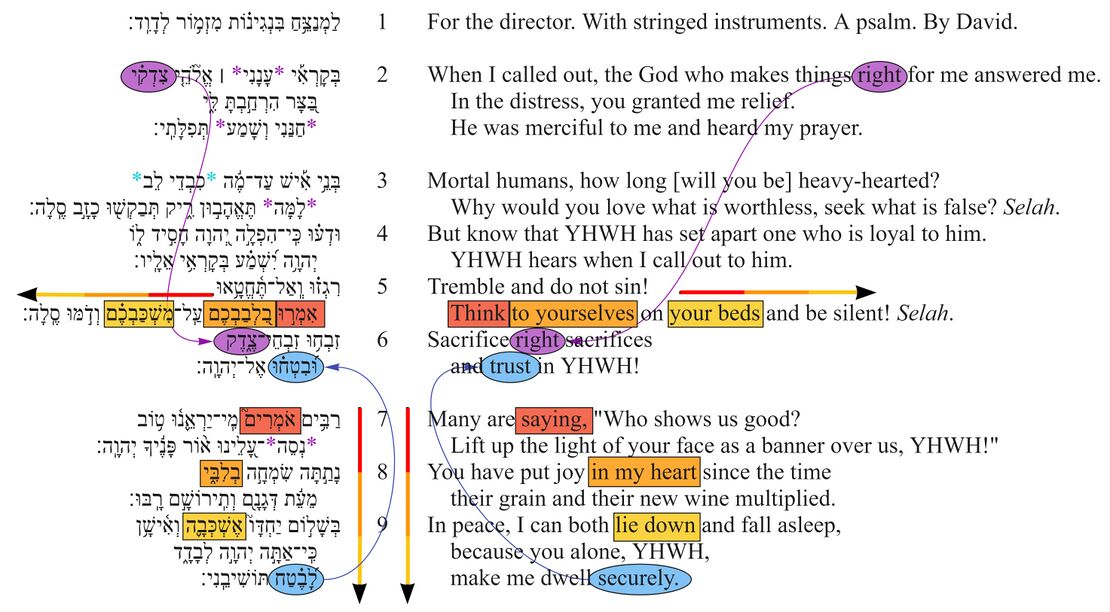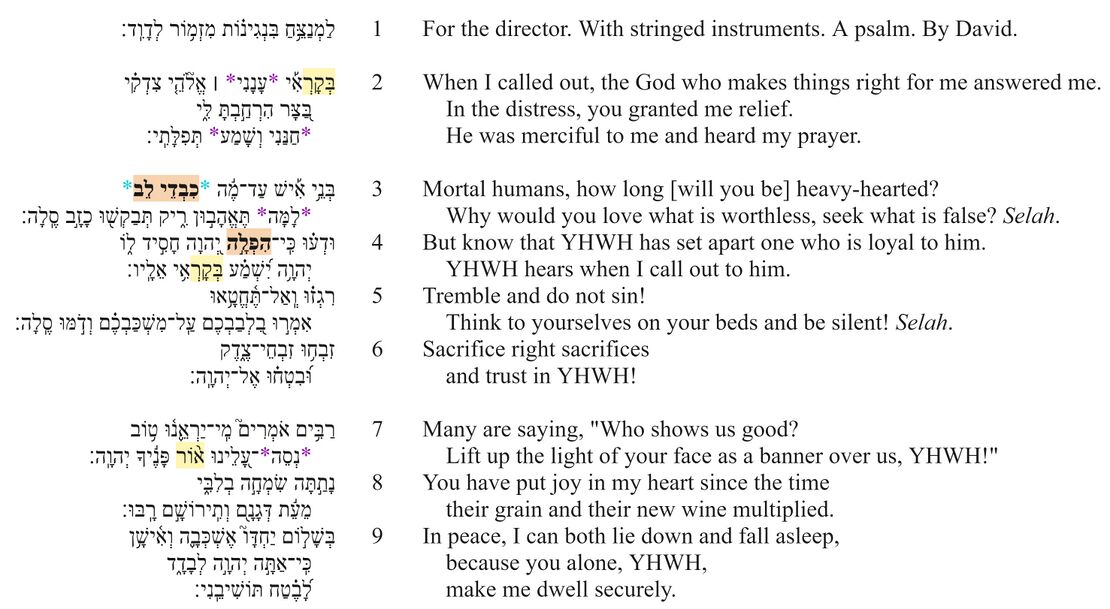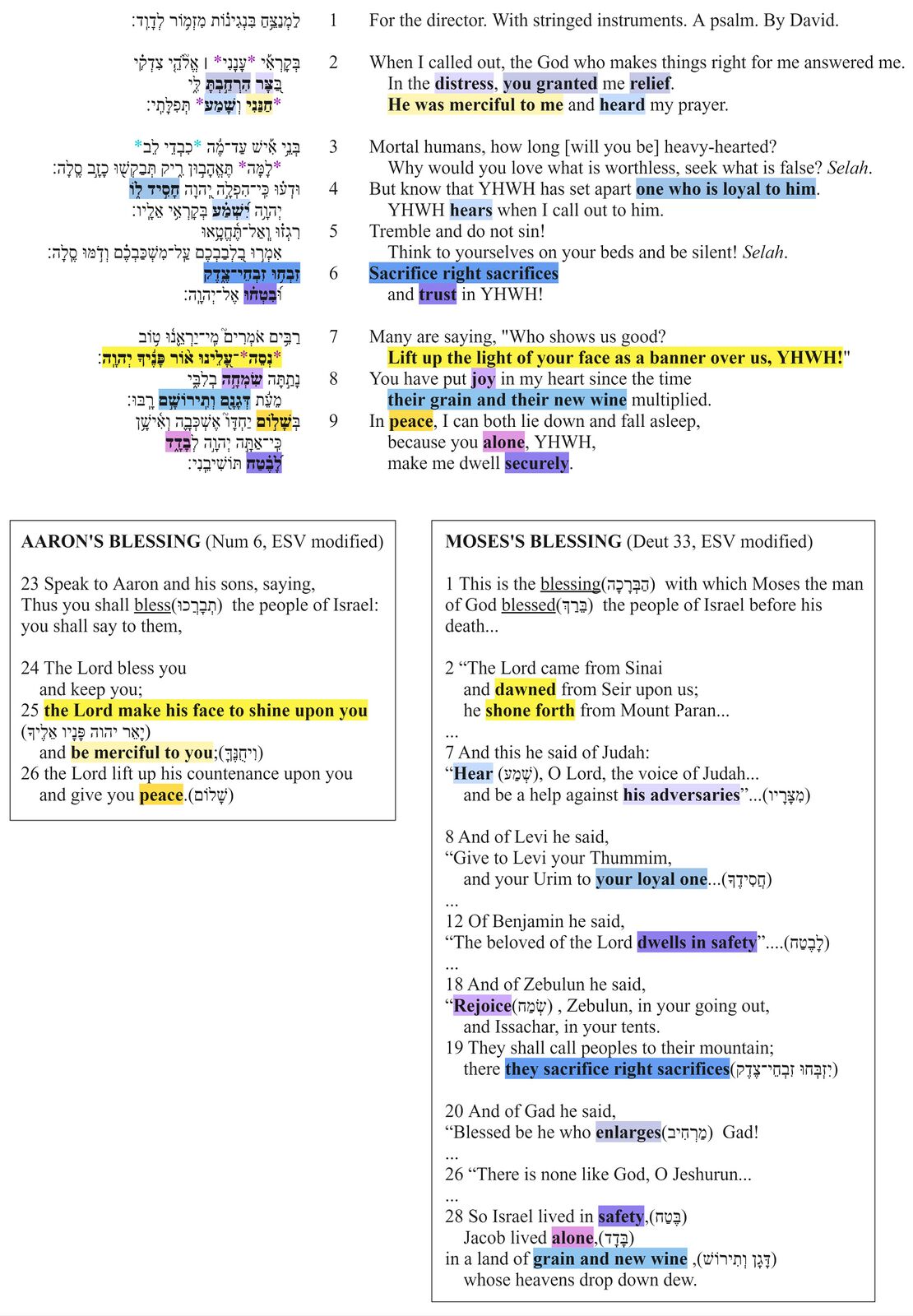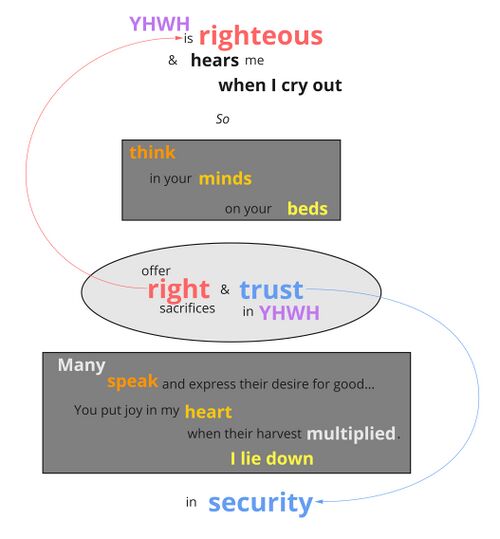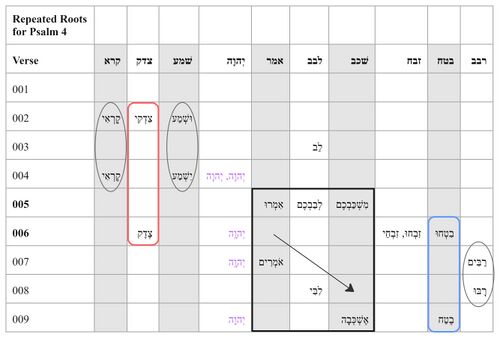Psalm 4 Poetic Features
Poetic Features
In poetic features, we identify and describe the “Top 3 Poetic Features” for each Psalm. Poetic features might include intricate patterns (e.g., chiasms), long range correspondences across the psalm, evocative uses of imagery, sound-plays, allusions to other parts of the Bible, and various other features or combinations of features. For each poetic feature, we describe both the formal aspects of the feature and the poetic effect of the feature. We assume that there is no one-to-one correspondence between a feature’s formal aspects and its effect, and that similar forms might have very different effects depending on their contexts. The effect of a poetic feature is best determined (subjectively) by a thoughtful examination of the feature against the background of the psalm’s overall message and purpose.
Doubles
If an emendation or revocalization is preferred, that emendation or revocalization will be marked in the Hebrew text of all the visuals.
| Emendations/Revocalizations legend | |
|---|---|
| *Emended text* | Emended text, text in which the consonants differ from the consonants of the Masoretic text, is indicated by blue asterisks on either side of the emendation. |
| *Revocalized text* | Revocalized text, text in which only the vowels differ from the vowels of the Masoretic text, is indicated by purple asterisks on either side of the revocalization. |
Feature
Feature Nearly every root in v. 5b is repeated in vv. 7-9 in the same order in which they first appear in v. 5b:
- אמר - v. 7a ("saying") - v. 5b ("think")
- לבב - v. 8a ("heart") - v. 5b ("yourselves")
- שכב - v.9a ("lie down") - v. 5b ("beds")
Verse 6, which repeats none of the roots of v. 5b, repeats roots from the first line of the Psalm (צדק "right") and the last line of the Psalm (בטח "trust/securely").
Every repeated root is used once in relation to YHWH's people and at least once in relation to humanity:
- "many are saying" (אמרים) (v. 7) // "think" (אמרו) (v. 5)
- "my heart" (לבי) (v. 8) // "your hearts " (לבב) (v. 5) "heavy-hearted" (v. 3)
- "I will lie down" (שׁכב) (v. 9) // "your beds" (משׁכב) (v. 5)
- "right for me" (צדק) (v. 2) // "(you) sacrifice right sacrifices" (צדק) (v. 6)
- "you make me dwell securely" (בטח) (v. 9) // "(you) trust in YHWH" (בטח) (v. 6)
Effect
David and Israel, whom he represents as king, show the world what it looks like to experience true blessing. YHWH has set David and Israel apart for special treatment (v. 4), and his blessing on them is like a "banner" to which others are called to rally (v. 7b).
In contrast, others put their hope in false and worthless gods (v. 3). In response, David addresses this mass of idol-worshipping humanity and says, in effect, "Look at how YHWH has blessed us! Come be like us! The security (בטח), rightly ordered well-being (צדק), joy-filled hearts (לב), and peaceful sleep (שׁכב) that our God gives to us can be yours as well, if you will imitate us and trust in him!"
A Bright Distinction
If an emendation or revocalization is preferred, that emendation or revocalization will be marked in the Hebrew text of all the visuals.
| Emendations/Revocalizations legend | |
|---|---|
| *Emended text* | Emended text, text in which the consonants differ from the consonants of the Masoretic text, is indicated by blue asterisks on either side of the emendation. |
| *Revocalized text* | Revocalized text, text in which only the vowels differ from the vowels of the Masoretic text, is indicated by purple asterisks on either side of the revocalization. |
Feature
The collocation "heavy" (כבד)–"heart" (לב), glossed here as "stubborn" (v. 3), is always elsewhere associated with the Exodus event and with the plagues in particular (Exod 7:14; 8:11, 28; 9:7, 34; 10:1; 1 Sam 6:6). The Pharaoh of the Exodus is the prototypical example of what it means to be "heavy of heart:" "Pharaoh’s heart is stubborn (כָּבֵד לֵב פַּרְעֹה), and he still refuses to let the people go" (Exod 7:14, NLT).
Similarly, the word "set apart" in v. 4 (הִפְלָה) only occurs elsewhere in the account of the Exodus plagues (Exod 8:18; 9:4; 11:7), where it refers to YHWH's special treatment of the Israelites: "But on that day I will deal differently with (וְהִפְלֵיתִי) the land of Goshen, where my people live; no swarms of flies will be there, so that you will know that I, the Lord, am in this land. I will make a distinction between my people and your people" (Exod 8:18-19 [Eng: 22-23], NIV).
The "light" imagery in v. 7 and hinted at elsewhere in the psalm—the first word of the psalm, בְּקָרְאִי, sounds like the word for "morning," בֹּקֶר—also relates to the Exodus plagues. In the ninth plague (Exod 10:21ff), "total darkness covered all Egypt for three days... Yet all the Israelites had light in the places where they lived" (Exod 10:22–23).
Effect
The psalm alludes to the Exodus story and to the account of the plagues in particular. This story serves as an excellent illustration of the psalm's message: YHWH has uniquely blessed his people. The Pharaoh-like nations, who harden their hearts and seek after false gods (v. 3), refusing to acknowledge YHWH's supremacy, should recognize how YHWH has set apart Israel for special treatment (v. 4). While the rest of the world is living in darkness (cf. v. 5 "on your beds... be silent"), the "light" of YHWH's face (i.e., YHWH's favor and blessing) is raised over Israel like a banner, marking them out as unique and as a place to which others can rally (see the "banner" imagery chart).
Blessings Fulfilled
If an emendation or revocalization is preferred, that emendation or revocalization will be marked in the Hebrew text of all the visuals.
| Emendations/Revocalizations legend | |
|---|---|
| *Emended text* | Emended text, text in which the consonants differ from the consonants of the Masoretic text, is indicated by blue asterisks on either side of the emendation. |
| *Revocalized text* | Revocalized text, text in which only the vowels differ from the vowels of the Masoretic text, is indicated by purple asterisks on either side of the revocalization. |
Feature
Psalm 4 has several clear linguistic connections to two passages in the Torah: the Aaronic blessing in Num 6 and the Mosaic blessing in Deut 33 (see the visual). Nearly every verse of Ps 4 has at least one clear linguistic connection to one of these blessings (vv. 2, 4, 6, 7, 8, 9), and the majority of verses have multiple points of connection (vv. 2, 6, 7, 8, 9). Although the word "blessing" is never used in Ps 4, it is notable that Ps 4 follows Ps 3, and the last clause of Ps 3 says, "your blessing is on your people."
Effect
By alluding to these blessings in the Torah, Ps 4 presents itself as a celebration of YHWH's blessing on his people. From the perspective of Ps 4, the people have recently experienced YHWH's blessing in an abundant harvest (see v. 8), and now, drawing from the language of these two great blessings (Aaronic and Mosaic), they celebrate YHWH's provision and reflect on how these historic blessings are being fulfilled in their present experience.
Even the psalm's exhortation to the "mortal humans" to turn from idols and sacrifice right sacrifices to YHWH (vv. 3–6) is based in the Mosaic blessing, which says, "They will invite peoples to their mountain; there they will sacrifice right sacrifices" (Deut 33:19).
Repeated Roots
The repeated roots table is intended to identify the roots which are repeated in the psalm.
| Repeated Roots legend | |
|---|---|
| Divine name | The divine name is indicated by bold purple text. |
| Roots bounding a section | Roots bounding a section, appearing in the first and last verse of a section, are indicated by bold red text. |
| Roots occurring primarily in the first section are indicated in a yellow box. | |
| Roots occurring primarily in the third section are indicated in a blue box. | |
| Roots connected across sections are indicated by a vertical gray line connecting the roots. | |
| Section boundaries are indicated by a horizontal black line across the chart. | |
Notes
- Root repetition is especially prominent in this psalm.[1]
- Every verse has a repeated root in it
- Verses 5-6 have the highest concentration of repeated roots
- Almost every word of v. 5b is repeated in the following verses (vv. 7-8) in the order in which they appeared in v. 5b (marked with black box and arrow):
- The root אמר (v. 5b--> v. 7)
- The root לב (v. 5b--> v. 8)
- The root שׁכב (v. 5b--> v. 9)
- These repetitions reinforce the thematic significance of v. 5b, which is also the central, and longest, line of the psalm.
- Verse 6 repeats roots from the first (צדק; boxed in red) and last (בטח; boxed in blue) lines of the psalm, making it central to the psalm's structure.[2]
- The repetitions of קרא + שׁמע (vv. 2-4) and רבב (vv. 7-8; all circled in black) have poetic structure significance (see poetic structure).


